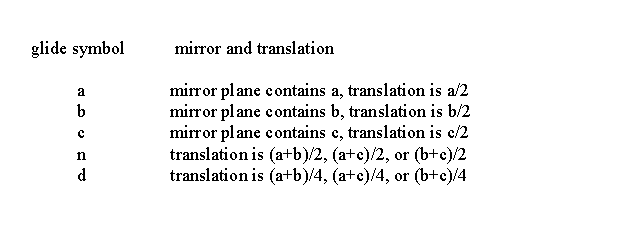Glide Planes
Glide planes. If you add translations to mirrors, you generate glide operations. These get just a bit complicated because in addition to defining the orientation of the glide plane with respect to some axes, you also need to define the direction of the translational component. Here's an example of an a glide, perpendicular to the b axis.
First, let's look at the case where the b axis is coming out of the page with a going off to the right.

The symbol for the glide in the plane of the board is similar to a mirror, but with an arrow attached to one of the sides of the symbol to denote the direction of the translational component of the glide.
The object at x,y,z is translated 1/2 along a and mirrored along the b axis to 1/2+x, -y, z.
What would this look like if the b axis were in the plane of the board pointing down and the a axis goes to the right?

The dark line denotes the operation as carried out; the object is translated 1/2 along the a direction and then transformed across the mirror plane.
The symbol now is like that of a mirror perpendicular to the board, i.e., a line, but this time a dashed line with the dashes going the direction of the translational part of the operation.
Now try the case where b points down and a points out of the board.

Here the symbol for the glide is a dotted line (meant to represent the tails of the dashes showing the direction of the glide).
Here's a listing of the five different glide operations found in crystals.

 back to index
back to index
 next topic
next topic
 previous topic
previous topic
copyright © Ron Stenkamp stenkamp@u.washington.edu Most recent update 1/7/97